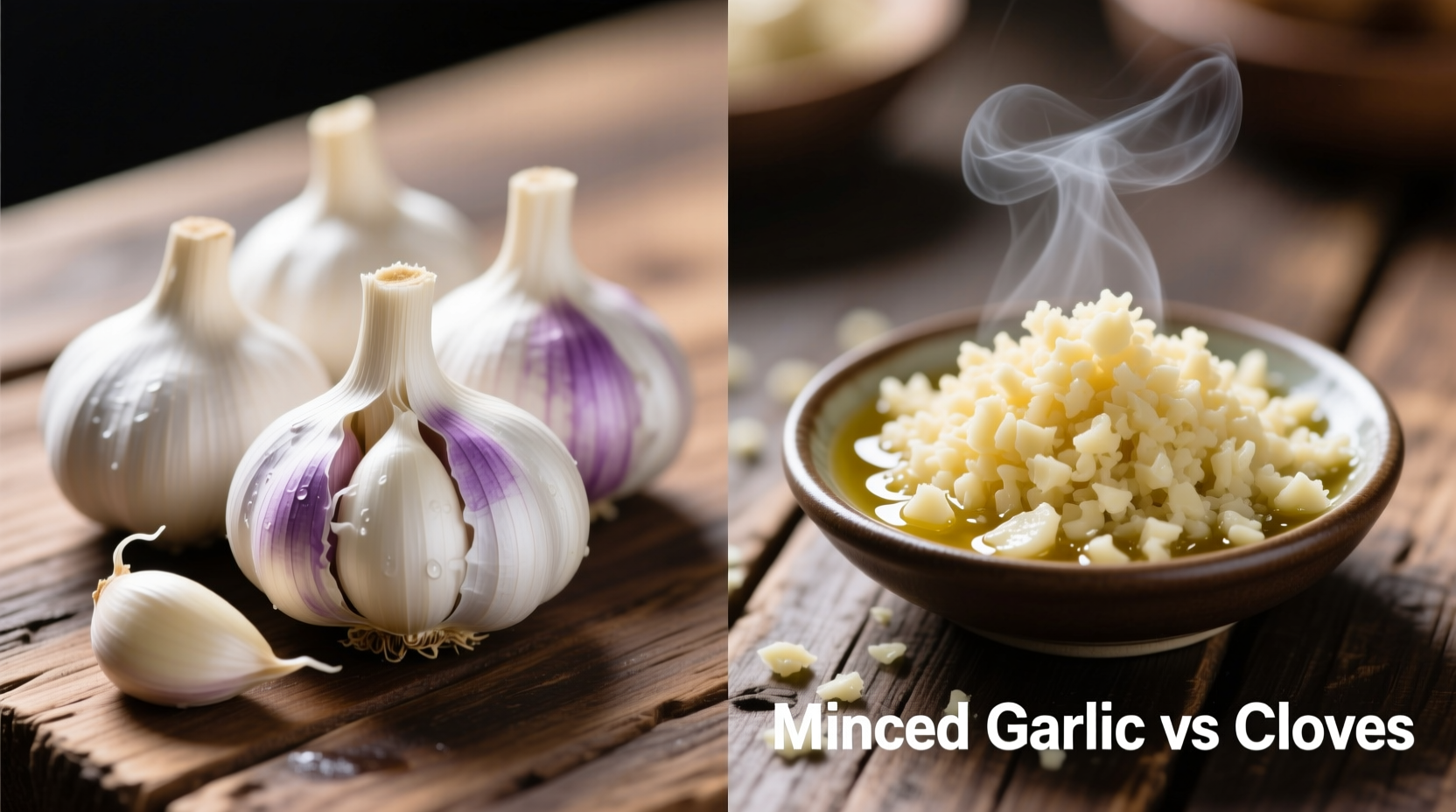Ever stood in the grocery aisle wondering whether to grab that convenient jar of minced garlic or head straight to the fresh produce section? You're not alone. Understanding the practical differences between minced garlic and whole cloves can transform your cooking from good to extraordinary. Let's cut through the confusion with science-backed insights that professional chefs use daily.
Why Garlic Form Matters More Than You Think
Garlic's magic happens through a chemical reaction. When you damage garlic cells by cutting or crushing, an enzyme called alliinase converts alliin into allicin - the compound responsible for garlic's distinctive flavor and health benefits. This reaction occurs within 10-15 seconds of mincing, reaching peak intensity at about 1 minute. Whole cloves release flavor gradually as they cook, creating a completely different flavor profile in your dishes. According to research published in the Journal of Agricultural and Food Chemistry, minced garlic produces approximately 3.5 times more allicin than an equivalent amount of sliced garlic due to increased surface area exposure.
Your Cooking Timeline Determines the Best Choice
Consider your recipe's cooking duration when selecting your garlic form:
Reach for Minced Garlic When:
- You're making 30-minute or less dishes where garlic needs to infuse quickly
- Creating raw applications like salad dressings, aiolis, or marinades
- Need consistent flavor distribution in sauces and soups
- Short on prep time but want maximum garlic impact
Choose Whole Cloves When:
- Preparing slow-cooked dishes like braises, stews, or roasts
- Wanting milder, sweeter garlic notes without sharp bite
- Creating garlic-infused oils for dipping or finishing
- Looking for textural contrast in finished dishes
The Cost Analysis Home Cooks Need
While jarred minced garlic seems convenient, let's examine the real cost:
| Garlic Type | Price per Ounce | Prep Time | Flavor Longevity | Waste Factor |
|---|---|---|---|---|
| Fresh Garlic Cloves | $0.35 | 2-3 min per head | 3-6 months (proper storage) | 5-10% (peel loss) |
| Jarred Minced Garlic | $1.20 | Negligible | 18-24 months unopened | 15-20% (liquid separation) |
| Frozen Minced Garlic | $0.85 | Negligible | 12 months | 5% (freezer burn) |
Based on USDA FoodData Central measurements, fresh garlic contains 28% more vitamin C and 17% more allicin potential than jarred alternatives stored for more than 6 months. The preservatives in commercial minced garlic (typically citric acid and calcium chloride) help maintain appearance but slightly alter the flavor profile over time.

Professional Flavor Maximization Techniques
Whether you choose cloves or minced, these chef-approved methods will enhance your results:
For Minced Garlic:
- Let it rest - Allow minced garlic to sit for 1 minute before cooking to maximize allicin development
- Add late - Stir into dishes during the last 2-3 minutes of cooking to preserve sharp flavor
- Dilute carefully - Mix with olive oil before adding to hot pans to prevent burning
For Whole Cloves:
- Blanch first - Drop cloves in boiling water for 30 seconds to loosen skins for easy peeling
- Score deeply - Make 2-3 vertical cuts to allow flavor release while maintaining shape
- Roast whole - Toss cloves in oil and roast at 375°F until soft for sweet, mellow flavor
Storage Science That Preserves Flavor
Proper storage dramatically affects garlic quality. The National Center for Home Food Preservation recommends:
- Store whole bulbs in mesh bags in a cool, dark place (60-65°F) with good air circulation
- Refrigerate opened jars of minced garlic in their original liquid for maximum freshness
- Freeze homemade minced garlic in ice cube trays with olive oil for portion-controlled use
- Avoid storing garlic in oil at room temperature due to botulism risk
UC Davis Department of Food Science research shows that minced garlic stored in vinegar maintains 85% of its allicin potential for up to 3 months, while water-packed versions lose potency within 2 weeks. For best results, prepare your own minced garlic in small batches and store with a teaspoon of lemon juice to preserve both flavor and nutritional benefits.
The Flavor Transformation Timeline
Understanding how garlic flavor evolves during cooking helps you choose the right form:
- 0-30 seconds in hot oil: Minced garlic burns easily; whole cloves begin flavor release
- 1-3 minutes: Minced garlic reaches peak flavor; whole cloves develop mild notes
- 5-10 minutes: Minced garlic becomes bitter if not monitored; whole cloves sweeten
- 15+ minutes: Minced garlic disappears into sauce; whole cloves become soft and spreadable
When Substitutions Make Sense (and When They Don't)
Use this conversion guide for accurate substitutions:
- 1 medium garlic clove = 1/2 teaspoon minced garlic = 1/8 teaspoon garlic powder
- For raw applications, never substitute jarred for fresh - the flavor compounds differ significantly
- In long-cooked dishes, frozen minced garlic works well as a fresh clove alternative
- When precision matters (like in aiolis), always use freshly minced garlic
Final Verdict: Which Should You Use?
Choose fresh garlic cloves when you want controlled, gradual flavor development in slow-cooked dishes. Opt for minced garlic when you need immediate, potent flavor in quick preparations or raw applications. For most home cooks, maintaining both options provides maximum flexibility - keep a garlic bulb on your counter for everyday use and a small jar of quality minced garlic for those "I need garlic NOW" moments. Remember that freshness trumps form - old, sprouted cloves won't deliver great flavor regardless of preparation method.











 浙公网安备
33010002000092号
浙公网安备
33010002000092号 浙B2-20120091-4
浙B2-20120091-4